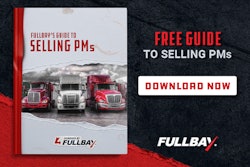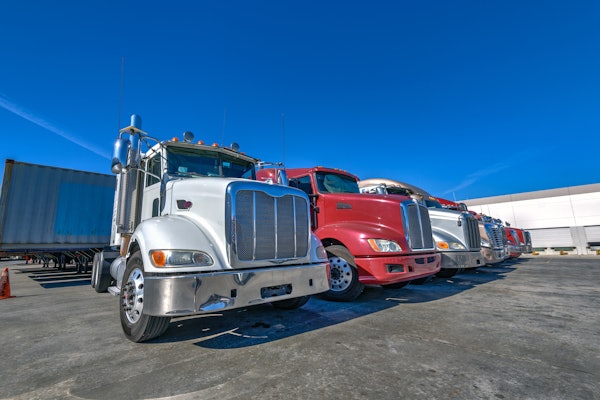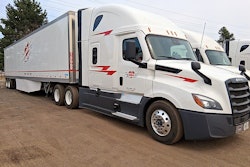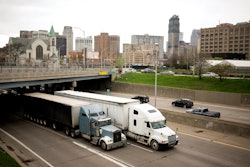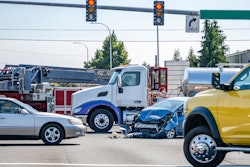Even aluminum can corrode, as damaged fuel tank shows.
During routine truck inspections a few years ago, Roy Gambrell was alarmed to notice pronounced cracking – bad enough for an out-of-service citation – on brake-shoe linings that were only 30 to 35 percent worn. “Usually, you think of lining cracking as a heat problem generated by imbalanced brakes,” says Gambrell, director of maintenance for Franklin, Ky.-based Truck-It Inc. “But we don’t have imbalance issues. I knew it was something else.”
Don’t want no rust, Jack
The problem turned out to be a relatively new phenomenon called rust jacking – a process wherein brake shoe tables rust severely under the linings, causing surface irregularities of nearly 1/4 inch. As the brakes are applied, the linings repeatedly are pushed against the drum with uneven pressure across the shoe table, causing the linings to crack over the edges of the high spots.
The root cause? While good old salt always has done a good job melting ice and snow – and, unfortunately, corroding metal – highway departments in snow-prone states have discovered that other compounds such as calcium chloride and magnesium chloride do a better melting job, and are far cheaper. They also are far more corrosive, often to critical vehicle safety components like brakes.
This condition is found most often in shoes that have been relined without being prepared and painted properly, but it does occur in OE shoes as well. Even with brand new shoes, “I still have to discard them with about 30 percent wear left on them,” says Gambrell. And the problem has gotten worse with the introduction of long-life brakes. “The linings last longer,” he acknowledges. “But that means brake shoes spend a longer time exposed to the elements.”
No component safe
“It’s been tough getting people to realize the damage this stuff can do,” says Gambrell. “Even to tires. Think about it – if there’s a small nick in the tread, these chemicals can wick their way up to the steel belts and corrode them.”
And it’s not just steel or other ferrous alloys that get attacked. “I’ve seen holes eaten in aluminum fuel tanks,” he attests. “No part on a truck is safe.”
Nor does it appear that the problem is getting better. Due to the low cost of the chemicals and their effectiveness at clearing roads, “it’s getting worse,” Gambrell says. “The highway departments figure that, if a little is good, more must be better.”
While damaged brakes, tires and fuel tanks constitute a safety hazard, non-safety components also can suffer. “I’ve seen oil pans rusting out,” says Darry Stuart, president of DWS Fleet Management Services, based in Wrentham, Mass. “Also, clutches, radiators corroding from the outside, you name it.”
“The problem must be getting pretty bad,” agrees Bob Deal, a veteran fleet manager from Anderson, S.C., and recipient of CCJ’s 2003 Career Leadership Award. “I was recently checking out some fairly new tractors, and the fifth-wheel attachment bolts were so badly rusted that I could penetrate them with my pocket knife.”
Dave Foster, vice president of field maintenance for Columbia, S.C.-based Southeastern Freight Lines, says his fleet hasn’t experienced anything catastrophic. “Since we run mainly in the South, the only trouble we’ve had, aside from brakes a few years ago, is with vehicles that are domiciled in northern Virginia,” says Foster, recipient of CCJ’s 2004 Career Leadership Award. “We have had some frame corrosion and a lot of horizontal muffler replacements on our P&D vehicles.”
“Magnesium chloride, in particular, is sticky stuff,” says Greg Fulton, president of the Colorado Motor Carriers Association. “And they put it down as a liquid long before it starts to snow, so it’s in its pure, undiluted form. Not only does it kill roadside vegetation, but it clings to vehicles running through it, causing rapid corrosion – and difficult removal.”
Could the metal used to build trucks be partly to blame? Gambrell and Stuart are convinced of it. “A lot of the metal used is recycled from older, scrapped vehicles,” Stuart says. “I really believe that some of the properties that are conducive to corrosion stay with the metal through the recycling process. I’ve had ‘new’ diamond-plate decking rust so badly, I could scrape it off in sheets the size of tortillas.”
Trailers not immune
Corrosion of truck and tractor components isn’t the only worry; trailers are taking their share of the hit. “I’ve had trailer webs with holes so big you could put your hand through them,” says Stuart. “That’s why I started spec’ing stainless steel and aluminum subframes, but that added $4,000 to the cost of each trailer, and the fleet almost had my head.”
No doubt, trailer manufacturers are taking more precautions against corrosion, but the war is far from over. “Corrosion is still getting worse,” Stuart says. “We’re seeing better coatings and, just driving on the highway, you can see a lot more stainless and galvanized steel. But the use of these new chemicals is spreading faster than the industry can keep up.”
What to do?
So, what can a fleet operator do to minimize corrosion damage? For brakes, advises the Corrosion Abatement Task Force of the Technology & Maintenance Council, visit the shop that produces your relined brake shoes. Make sure they’re measuring shoes properly for conformity, and discarding those that don’t make the grade. Look at surface-preparation, painting and riveting techniques. Shoe tables should be smooth and protected from corrosion before linings are installed. Rivets should be tight, and linings firmly and uniformly in contact with the entire shoe table, with no movement possible.
“We used to have some brake-shoe corrosion problems,” says Foster, “so we went back to our relining supplier and said, ‘What are you doing to prevent this?’ Turns out, he had all the right procedures in place, but they weren’t necessarily being followed. Since then, the quality has improved. Every now and then we’ll see some shoe corrosion, but we really don’t have much of a problem anymore.”
Although he admits he’s no fan of brake dust shields, Stuart revealed that, after doing inspections at several snow-belt truck fleets, all had rust-jacking problems except one. “That one used dust shields,” he says. “But dust shields are not a guarantee that you won’t have problems. If you use them, maintain them. If you don’t, they’re worse than not having them, since they can trap the chemicals in the brake assembly.”
For frames, cabs and other components, “There’s not that much you can do,” Stuart adds. “High-quality paint and coatings help, but each time you get a nick, that’s a place for corrosion to start, and it spreads under the paint or coating.”
Clearly, manufacturers must take some responsibility. In a Future-Truck position paper, Recommendations for Corrosion Abatement, TMC offers a road map to vehicle manufacturers, which asserts that: no component should need to be replaced prematurely due to corrosion; corrosion protection should last eight years for trucks and tractors, and 16 years for trailers; and it should be warranted fully for those periods, with 100 percent on parts and labor.
While the paper does not specify materials or processes for manufacturers to achieve these goals, it does suggest more realistic testing – particularly for electrical components – and building for worst-case scenarios, e. g., assuming all vehicles eventually might be operated in northern states or in coastal areas.
Early in TMC’s Corrosion Abatement Task Force discussions, there was talk of petitioning various DOTs to use less aggressive chemicals, but “that’s not likely to happen,” says Stuart. “Public opinion and media pressure dictate that roads stay as clear as possible.”
“We haven’t made much headway with the Colorado DOT,” attests Fulton. “They’ve at least shortened the window between application and the arrival of snow. But we’re hoping that with a new, incoming DOT director, we can start fresh and make some progress. We recognize that roads need to be kept clear, but we’d like to get all parties involved and come up with a product that’s effective, but without significant corrosion effects.” A challenge, he adds, is that corrosion inhibitors, which could be added to the mix to make it less destructive, usually contain metals. “And that can cause waste-water problems when the de-icing agent is washed off.”
“For now, the best thing you can do is keep things clean,” says Stuart. “Fleets that operate in snow-prone areas should regularly use an environmentally safe detergent to carry away as much residue as possible. That’s going to be even more important over the next few years,” he concludes, “as trucks are kept in service longer to avoid the added costs associated with new models.”
Putting the brakes on corrosion
Brakes are the most safety-critical component on trucks, and brake suppliers have recognized the dangers of chemically induced corrosion. They are taking steps to retard it.
“The problem seems to be mostly on steer and trailer axles,” says Prakash Jain, director of joint ventures and licensees for ArvinMeritor. “Drive axles generate enough heat that the moisture dissipates. When the new stopping-distance requirements take effect, front brakes will be doing more work and also will generate more heat.
“Trailer brakes will still be an issue. We’re looking at bonding linings to brake shoes, but that will create a relining challenge. We don’t have a permanent solution yet, but we’re sure we’ll find it.”
“For our new brake shoes, we’re using all new steel,” says John Hawker, service engineer for Bendix Spicer Foundation Brake. “We then e-powder-coat them, which fills in all voids due to the attraction of an electrostatic charge, and bake them for an epoxy-like finish.” Hawker says that while Bendix has seen some other shoes start rusting after only 100 hours of salt-spray testing (ASTM B 117-97), “ours have gone 2,000 hours.”
As the e-coat process would be too expensive for relined shoes, “We give relines two dips in DuPont Tufcote, and bake them,” says Hawker. “They won’t last quite as long as our new shoes, but they’re a lot better than untreated, relined shoes.”
Hawker cautions that any brake shoe should be installed carefully to avoid nicks and scratches, which will become initiation sites for corrosion. He also advises checking S-cams, wheels, studs and nuts, as these also are susceptible to corrosion.
Meanwhile, Haldex has come up with a protective coating that provides rust resistance with high solid content and corrosion inhibitors. The coating application process ensures shoes are properly coated, cured and ready for lining, the company says. Reportedly, when subjected to salt-spray testing, coated shoes fared far better than untreated control shoes. When used with Haldex friction material, coated shoes are guaranteed against lining edge cracking from rust jacking for the life of the block.
“The program has been successful and has greatly reduced occurrences of rust jacking,” says Randy Petresh, Haldex’s vice president of technical services. “Returns have decreased significantly, so we’re seeing better core life. We’re not throwing shoes away.”

